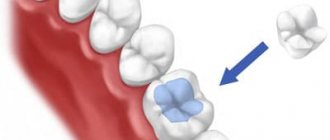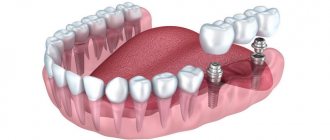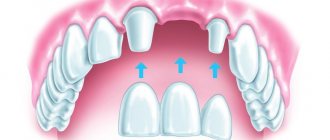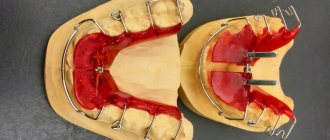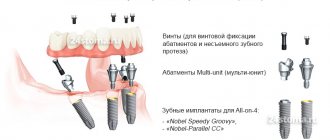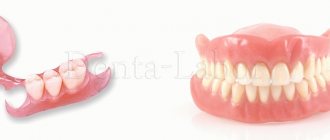Causes of structure failure
Can a dental bridge fall out immediately after installation? The reasons that a permanent dental bridge falls off after a few days, weeks (less often, months) most often lie in errors in its manufacture or fixation. But the patient’s own fault may also be present here. Let's take a closer look at the factors that cause loss in the early period:
- the use of low-quality cement or its incorrect application,
- the presence of a gap between the inside of the prosthesis and the supporting teeth on which it is placed,
- caries under crowns: this may be undetected caries - it was not noticed during preparation for prosthetics. Or when the supporting tooth was overheated during turning. If, during the passage of root canals, they are poorly processed or sealed, then over time this leads to the spread of infection,
- allergy to prosthetic materials,
- if the patient chewed something very hard with his teeth (including artificial ones), chewed toffee, toffee.
Another reason for loss is poor oral hygiene, when a large amount of plaque and stone accumulates around the crowns. This in itself can lead to the destruction of the ceramic or composite coating of the bridge and partial crumbling of the cement composition. If we consider that dental deposits are inhabited by bacteria that have a negative effect on the gums and roots of the teeth under the prosthesis, then loss can occur due to progressive caries on the supports.
A dental bridge fell out – reasons?
There are several reasons:
- The patient's diet contains sticky foods;
- Sediment has accumulated along the edges of the crown;
- The cement has lost its properties due to the expiration date;
- Habit of chewing hard objects;
- Caries develops under the crown, since pulpless teeth have reduced resistance to negative factors;
- Low teeth do not allow for high-quality fixation;
- Worn cement that does not allow for reliable fixation, then to correct the situation, gently re-fixate using a reliable composite.
- Biomechanical factor – incorrect distribution of chewing load.
Relationship between loss and service life
Dental bridges can fall out due to natural wear and tear or the end of their life. On average it is 5 years. And with good oral hygiene and careful treatment, the bridge will last up to 10 years. If the bridge is supported by implants, the service life increases. For ceramic and metal-ceramic it is at least 10 years, and for zirconium dioxide and ceramic-composite – from 20 years.
“My mother built golden bridges for herself back in the 90s. So, they stayed with her for almost 20 years. Either the doctor was such a good one, or she was taking care of her teeth. But she definitely never ate nuts. And I installed metal-ceramic ones in 2014. And they fell out after only 6 years. The doctor was able to glue them in place, but I understand that it is no longer so convenient. We'll probably have to change it."
Anastasia G., review from gidpozubam.ru
Conclusion
If the bridge is loose, the doctor will act in accordance with the clinical case.
If the situation allows, the depressurized structure should be removed and reinstalled with fresh cement. In more difficult conditions, it is not possible to remove the bridge without damaging it. The priority is to preserve the tooth. Therefore, a new bridge will have to be made. You should not delay your visit to the doctor, since under the shaky structure all conditions have been created for the development of pathogenic microorganisms.
To avoid loosening, it is necessary to regularly undergo preventive examinations with a doctor and follow his recommendations. Then the service life of the prosthesis will be maximum.
Author:
Mayorov Andrey Mikhailovich
Specialization:
orthopedic dentistry, dental prosthetics, implant installation
Rules of conduct when a bridge falls out
What to do if a dental bridge falls off? Often people get lost and don’t know how to behave. Someone almost begins to panic, someone hastily throws the fallen orthopedic structure into the trash. The list below includes simple and understandable rules that will tell you what to do when a dental bridge falls out:
- carefully spit everything out of your mouth onto a napkin if it falls out while eating,
- rinse your mouth with water and then with some solution (chlorhexidine or mouthwash),
- rinse the bridge in clean water, you can clean it with a soft bristle brush: when rinsing and cleaning, make sure that it does not fall into the sink or onto the floor,
- place the prosthesis in a clean handkerchief or piece of sterile bandage,
- put the bridge in a small, clean container so as not to accidentally break the product (in case it can be glued back, although this is unlikely). You will need to take the prosthesis to the clinic in the same container,
- try not to chew on the “affected” side, and also rinse your mouth after each meal (if there is still a lot of time before your visit to the clinic).
When the bridge falls out from clenching the jaws, from pressing with the tongue - that is, when there was no food in the mouth, then immediately go to point number “2” of this list.
If it suddenly turns out that the bridge was swallowed along with food or liquid, then you need to immediately contact a clinic - for example, a therapist, pediatrician, or a hospital emergency room. The sharp edges of the structure can injure the gastrointestinal tract; the bridge can get stuck in the esophagus or intestines. Therefore, you will need to undergo an x-ray or ultrasound. It is important not to make active movements, not to bend over and to adhere to the diet prescribed by the doctor - so that the structure leaves the body naturally. Otherwise, you will have to undergo emergency surgery.
How is diagnostics carried out?
What to do if the dental bridge starts to loosen? Or if it wobbles, but only on one side? In general, if the instability of a bridge is detected, as well as before prosthetics in general, it is imperative to undergo an examination. Often the first step is X-ray diagnostics - and optimally, if this is a computed tomography (CT) scan of the jaw. Because ordinary spot and panoramic images produce a “flat picture” on one side, but CT is a three-dimensional image from all sides. Those. It is almost impossible not to notice any pathological process using tomography.
The dentist also visually and with the help of instruments assesses the condition of the oral cavity, the mobility of the prosthesis - sometimes the structure can “fly off” from the supports even during the examination. The patient is asked about associated symptoms and their duration - pain, bleeding, unpleasant odor from under the crowns, etc.
Is it possible to glue the bridge in place yourself?
What to do and how to secure a dental bridge if it falls out at home? Let us immediately point out that putting a fallen bridge back on your own is not the best idea. Since this can injure the supporting and neighboring teeth, harm the gums (if you suddenly decide to glue the bridge with pharmaceutical cement or household glue). The consequences can be unpredictable - up to the removal of “damaged” teeth or implants. Therefore, it is better to entrust your teeth to a professional dentist.
Bridge design
The main parts of a bridge are artificial teeth (sometimes simulating part of the gum) and fastening in the form of dental crowns, inlays or clasps. In appearance, all this resembles a bridge, hence the name of the prosthesis. Bridges are used to replace from 1 to 4 missing teeth in a row, depending on their type. In this case, to the right and left of the dentition defect there must be healthy teeth that can become a support for the prosthesis and withstand additional chewing pressure, which can reach several tens of kilograms.
The intermediate part of the bridge may have different principles of connection with the mucosa:
- Flushing
. When there is space between the mucous membrane and the dental bridge. A flushable bridge allows food to pass freely under the body of the structure, facilitating hygienic care.
- Tangent
. When the body of the prosthesis touches the mucous membrane on one side, which is important for the anterior area of the teeth, where it is important from a functional, speech and aesthetic point of view. A bridge of this type is usually installed on the front teeth.
- Saddle
. When the dental bridge is completely connected to the mucous membrane, joint to joint. This is not the best option in terms of functionality and reliability, but there are cases when you cannot do without it, for example, in the area of the front teeth.
What will the doctor do?
Which doctor is best to see if a dental bridge has fallen off? In general, dental prosthetics is the domain of an orthopedic dentist. If the prosthesis is on implants, then you will need to visit both an orthopedist and an implantologist, because The problem may be with the implant. Will the doctor be able to fix the old prosthesis? Here you will first need to undergo diagnostics, incl. tomography of the jaw, which will help determine the condition of the bone around the roots, the quality of root canal filling, and identify cracks in the roots.
Read on the topic: features of dental bridges - who is suitable for them, how they are made and installed.
If the support is in order and suitable for prosthetics, and the prosthesis itself has no flaws (i.e., the problem of falling out was only due to low-quality cement), then you can try to glue the old bridge in place. Of course, using new and high-quality cement.
If the doctor considers that the support needs treatment or removal, and also if the prosthesis is made incorrectly or is broken, then in addition to the main treatment, it will be necessary to make a new orthopedic bridge structure or, in principle, a different type of prosthesis.
Reasons for loosening of the crown on the pin and inlay
The reason that the crown on the pin began to wobble depends on cementation and correct installation:
- When bonding with dental cement, the quality of the material is of great importance. Its task is to seal the gap between the tooth, the pin and the crown.
- Incorrect installation of the pin (fiberglass pin) in the channel. To use a post, it is important that most of the tooth is preserved. The pin is responsible for stability, but the crown is held on the tooth. If the pin is poorly secured or the tooth is severely damaged, the denture will wobble.
The inlay, unlike the pin, consists of two parts, the pin itself and an element that replicates the tooth. The crown on the inlay is loose if:
- de-cementing occurred;
- parts of the tab have become disconnected.
Re-prosthetics in cases where pins and inlays are used will take longer. It is necessary to install microprostheses in compliance with the technique, correct the defects that led to the loss, and then install a new crown. Attempts to fit a microprosthesis to an old restoration will lead to the fact that the entire structure will have to be changed again.
What to do if a temporary bridge falls out
If the temporary bridge falls out, then there is nothing to worry about. After all, it is glued to temporary cement, which has weaker fixing properties. Therefore, you need to contact an orthopedist to glue the structure in place. Or, if a permanent prosthesis is already ready or the implants have taken root, then the temporary bridge will not be put back, but the permanent one will be fixed immediately.
Complex on 4 OSSTEM implants with delayed loading - from RUB 170,000.
Complex implantation Osstem (South Korea) with delayed loading after 4-6 months.
Guarantee for the doctor’s work - unlimited Call now or order a call
Opening hours: 24 hours a day - seven days a week
What to do if you swallow a tooth crown
When a crown falls out, it is often swallowed, especially if the incident happened at night. No need to worry: the prosthesis is made from non-toxic materials, so poisoning will not occur. However, you still need to quickly seek medical help.
Promptly contact a specialist
Usually the crown falls out without a pin, but if it is also swallowed, complications are possible , because it is made of durable metal. It is difficult for the human body to digest such material. There is also a danger from a crown that has broken off under mechanical stress, that is, it has crumbled, forming sharp edges.
X-ray (survey) of the abdominal cavity
In any case, to refute or confirm this, you should immediately go to the doctor. If there is bleeding in the oral cavity, you should call an ambulance so that prompt assistance can be provided in case of damage to the digestive tract.
The doctor refers the patient for an x-ray examination . It allows you to identify the location of the swallowed crown and evaluate its shape: whether it has sharp edges and whether it poses a danger to human health. The doctor decides on the need for gastric lavage or gives an approximate time frame for the passage of a foreign body through the intestines naturally.
Gastric lavage
At the slightest suspicion of possible damage to the stomach or in case of obstruction of a foreign body, it is advised to perform lavage as soon as possible. For this, use a solution of furatsilin or another neutral agent. In rare cases, if the prosthesis reaches the intestines but does not come out, an enema with distilled water is used.
Esophagoscope
If the above methods do not help, resort to surgical removal of the crown using an esophagoscope . This flexible instrument is inserted under local anesthesia, the process is accompanied by tracheal intubation. Using video monitoring and special narrow forceps, the doctor first removes the crown, then the device itself.
After surgery, control contrast radiography is required. This procedure will allow you to identify signs of damage to the walls of the esophagus and prescribe treatment in a timely manner. So, for damage up to 0.5 cm in diameter, antibiotic therapy and rinsing are sufficient - the mucous membrane will recover within a few days.
How much does a re-restoration cost?
How much does it cost to put a dental bridge in place if it falls out? If the supports do not need to be treated or removed, then fixation with new cement will cost approximately 1000-1500 rubles. If the screws on dentures on implants have come loose, then fixing them with new screws will cost about the same. If the patient needs to treat/remove supports, install new pins or inlays - and, as a result, make a new prosthesis, then the cost of restoration starts at 30 thousand rubles. And the final cost is calculated individually.
Advantages and disadvantages
- Good functional performance.
- Aesthetics are above average.
- Low cost (except for prostheses on implants).
- Reliability and durability of the design (a classic prosthesis lasts an average of 7 - 8 years, with implant support - 15 or longer).
- The possibility of allergic reactions in the patient.
- Additional contraindications associated with the presence of metal in the prosthesis.
- Installation in the smile area is not recommended, since metal elements can shine through the ceramics; over the years, a noticeable blue line appears at the junction of the gum and the prosthesis.
What needs to be done to make the bridge last as long as possible
In order to extend the service life of the bridge, we must not forget that although it is an artificial structure, it should be treated like “natural” teeth. That is, do not load the bridges with excessively hard and stretchy food, regularly brush your teeth with a brush and toothpaste. Another important rule is that you need to visit an orthopedic dentist every 6 months. During a preventive examination, the doctor will examine the condition of the oral cavity and installed dentures, and will carry out professional removal of tartar and plaque.
1Yamamoto M. Basic technique for manufacturing metal-ceramic dentures, 1998.
Your questions and answers
QUESTION Hello, the bridge fell out of the teeth along with the pins. Can it be put back or not? And what is the best way to do this? Oksana
ANSWER Hello, Oksana. It's best not to try to glue the bridge in place yourself, because... This is fraught with complications, and consult an orthopedic dentist. Because there are many nuances due to which the old prosthesis can either be put back or not be used further (i.e., a new one can be made). But, given that your bridge fell out instead of the pins, most likely you won’t be able to put it back in place.
Author: Sambuev B. S. (Thank you for your help in writing the article and the information provided)
Methods for removing structures
How to remove once installed artificial products? Is it possible to carry out the procedure quickly and without sawing them? In general, it is possible, but it all depends on the indications, materials and strength of fixation of the product. Today there are several methods for this. It is important to proceed from the individual clinical picture of the patient, what goals are being pursued and what therapeutic indications are available. The methods differ in the time it takes to dismantle the prostheses and the cost of the procedure.
Using a Kopp apparatus
Colloquially, this special drill is referred to as a “crown remover.” Removing artificial installations from the front, lateral and chewing teeth using permanent or temporary cement, as well as from implants with its help is considered the most popular method today. When the device is turned on, it produces shocks that gradually break up the layers of cement located under the product. Next comes the tool, which is a hook. With its help, the orthopedist picks up the edge of the crown and removes it from the cement.
The method is considered low-traumatic and does not cause pain to the patient. The only downside of the method is that sometimes the Kopp apparatus scratches the surface of the crown, so it is unlikely that you will be able to use the prosthesis later - you will need to restore it.
Using the Coronaflex device
This device operates using compressed air. The shock wave supplied by the device specifically destroys the cement. The device operates much more carefully. The lining of the non-removable orthopedic structure does not suffer and is dismantled by the doctor without the slightest scratches or chips.
The instrument is expensive, so removing a permanent prosthesis using the Coronaflex device is not cheap. But it still saves the patient’s money – especially if the non-removable device is made of zirconium dioxide. If successful, the crown can even be reused.
Using ultrasound
With this method, crowns are removed from teeth by loosening the stability of the cement base. This is achieved by using the power of ultrasonic waves2. The removed prosthesis remains completely intact and unharmed.
However, remember: this method is not suitable for every material. If the orthopedic device is fixed to glass ionomer cement (a mixture of polyacrylic acid and aluminofluorosilicate glass powder), ultrasound is powerless.
Traditional sawing
This is the crudest, but at the same time the most accessible of all the listed methods. The method is suitable for dismantling ceramic, metal and metal-ceramic crowns. No, contrary to misconceptions, the patient will almost feel pain during the removal of the device. You won't even feel slight discomfort. But the procedure is quite time-consuming. In addition, the integrity of the removed element, which is understandable, cannot be preserved. So for subsequent prosthetics you will need to make a new crown.
On a note! Sawing or saving? It all depends on the purpose of removing the structure. If we are talking about treating a tooth under a crown, then you need to use the most gentle methods so that the prosthesis can be re-attached. If the service life of the product has expired, then it is easier to saw it, because you will still have to carry out re-prosthetics.
Other methods
Today, dentists also use additional methods of removing dentures from permanent and temporary cement, if the patient needs it. Modern pneumatic tools, devices with a hook tip, forceps, a jackhammer, a “Metalift” apparatus and an “Auto Abdicator” crown remover are used; the dental bridge is dismantled using a Higa apparatus. Some removal methods are performed under local anesthesia.
Possible complications
The loss of a denture causes the appearance of an open wound or unprotected area in its place. Bacteria get there with food and lead to infection. Therefore, when breaking off a crown, it is necessary to rinse the resulting cavity with a disinfectant solution, for example, chlorhexidine, to avoid infection. Next, you need to consult a doctor who will promptly close the wound using temporary materials.
If a dental crown gets into the digestive organs, it can cause problems in their functioning. Sometimes a foreign body causes intestinal disorders, vomiting, and nausea. If you managed to get the swallowed object naturally, then possible symptoms will stop bothering the person almost immediately.
If the crown damages the walls of the esophagus or stomach, the following signs are observed:
- bleeding from the mouth;
- pain when swallowing;
- nausea;
- body temperature rises to 39 °C;
- painful sensations when turning the neck or torso.
This leads to the development of peritonitis, internal bleeding, and intestinal obstruction. In the absence of timely assistance within several days, death from blood loss and general exhaustion of the body cannot be ruled out.
What to do: first aid for adults and children
Among the recommendations on what to do if you swallow a denture is to consult a doctor for advice. The doctor assesses the chances of natural removal of the product based on x-rays. It is important for him to know the shape and presence of sharp edges, which, when passing through the intestines, can damage the epithelium.
Doctor's actions
The main task of the doctor:
- establish the type of prosthesis, its shape and material;
- if necessary, request data from the treating dentist;
- if there is no information, order an x-ray.
If a child has swallowed one of his baby teeth, an enema or gastric lavage may be recommended. For an adult patient, an esophagoscope is used - a special device that allows you to carefully remove the prosthesis through the esophagus.
If a child swallows a tooth
In the period from 6 to 11 years, active replacement of primary teeth with molars occurs. They fall out painlessly, so a situation often arises when a baby eats a molar while swallowing food. Parents should not panic: they do not have sharp edges or roots.
A hearty lunch - as a solution to the problem of a swallowed prosthesis
To ensure tooth extraction naturally, doctors recommend feeding your baby foods that stimulate the intestines. If your child has swallowed an incisor, make him oatmeal with some pieces of prunes added. Beet salad, fermented milk products and sweet yogurt improve and speed up the process.
Prevention helps to prevent tooth swallowing. When brushing every day, you should inspect your mouth to look for chips or cracks. Every 6 months you should visit a dentist who checks the condition of the crown and prosthesis, the quality of cement or clasps.
